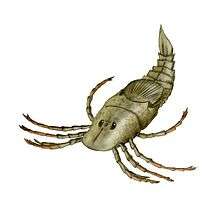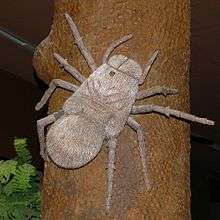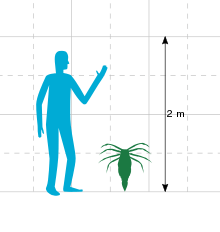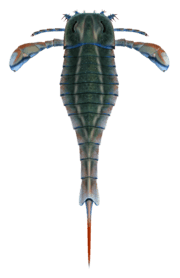Megarachne
| Megarachne | |
|---|---|
 | |
| Cast of the holotype specimen of M. servinei exhibited at the Museu de Ciències Naturals de Barcelona | |
| Scientific classification | |
| Kingdom: | Animalia |
| Phylum: | Arthropoda |
| Subphylum: | Chelicerata |
| Order: | †Eurypterida |
| Superfamily: | †Mycteropoidea |
| Family: | †Mycteroptidae |
| Genus: | †Megarachne Hünicken, 1980 |
| Species: | †M. servinei |
| Binomial name | |
| Megarachne servinei Hünicken, 1980 | |
Megarachne is a genus of eurypterid, an extinct group of aquatic arthropods. Fossils of Megarachne have been discovered in deposits of Late Carboniferous age, from the Gzhelian stage, in San Luis, Argentina. The fossils of the single and type species M. servinei have been recovered from deposits that had once been a freshwater environment. The generic name, composed of the Ancient Greek μέγας (megas) meaning "great" and Latin arachne meaning "spider", translates to "great spider", because the fossil had been misidentified as a large prehistoric spider.
With a body length of 54 centimetres (1.8 ft), Megarachne was a medium-sized eurypterid. If the original identification as a spider would have been correct, Megarachne would have been the largest known spider to have ever lived. Eurypterids such as Megarachne are often called "sea scorpions", but the strata in which Megarachne has been found suggest that it dwelled in fresh water and not in marine environments.
Megarachne was similar to other eurypterids within the Mycteropoidea, a rare group known primarily from South Africa and Scotland that had evolved a specialized method of feeding known as sweep-feeding in which they raked through the substrate of bodies of water in order to capture and eat smaller invertebrates. Despite only two known specimens having been recovered, Megarachne represents the most complete eurypterid discovered in Carboniferous deposits in South America so far.[1] Due to their fragmentary fossil record and similarities between the genera, some researchers have hypothesized that Megarachne and the other members of its family, Mycterops and Woodwardopterus, represent ontogenetic stages (different developmental stages of the animal throughout its life) of a single genus.
Description

Known fossils of Megarachne indicate a body length of 54 centimetres (1.8 ft). Whilst large for an arthropod, Megarachne was dwarfed by other eurypterids, even relatively close relatives such as Hibbertopterus which could reach lengths exceeding 1.5 metres (4.1 ft).[2] Though originally described as a giant spider, a multitude of features support the classification of Megarachne as an eurypterid. Among them, the raised lunules and the cuticular sculpture (a dividing ridge continuing uninterrupted throughout the carapace) of the mucrones (median spines on the carapace) are especially important since these features are characteristic of eurypterids.[1]
Megarachne possessed blade-like structures on its appendages which would have allowed it to engage in a feeding method known as sweep-feeding, raking through the soft sediment of aquatic environments in swamps and rivers with its anterior appendage blades to capture and feed on small invertebrates.[1] Megarachne also preserves a large and circular second opisthosomal tergite (the second dorsal segment of the abdomen), of which the function remains unknown.[1]
Megarachne was very similar to other mycteroptid eurypterids in appearance, a group distinguished from other mycteropoids by the parabolic shape of their prosoma (the head plate), hastate telsons (the posteriormost part of the body, often taking the shape of a spike or otherwise ornamented in eurypterids) with paired ventral keels[3] and the subtrapezoid-shaped heads with small compound eyes.[4]
History of research

Megarachne servinei was originally described in 1980 by the Argentinean palaeontologist Mario Hünicken. The generic name, composed of the Ancient Greek μέγας (megas) meaning "great" and Latin arachne meaning "spider", translates to "great spider". The holotype (now accessioned to the Museum of Paleontology at the National University of Cordoba as specimen CORD-PZ 2110) was recovered from the Pallero Member of the Bajo de Véliz Formation of Argentina, a locality dated to the Gzhelian Age (303.7 to 298.9 million years ago (Ma)).[1][5] The specimen preserves the carapace, the first two tergites, three partial appendages and what possibly is a coxa.[1]
Hünicken wrongly identified the specimen as a mygalomorph spider (the group that includes tarantulae) based on the shape of the carapace, the 15 millimetres (0.59 in) wide circular eye tubercle located between the two eyes in the center of the head, a structure in front of the carapace he identified as spatulate chelicerae, and a circular structure behind the first body segment which he identified as the "moderately hairy" abdomen. Hünicken's identification relied heavily on X-ray microtomography of the holotype and additional hidden structures, such as a sternum and labium, coxae and cheliceral fangs, were also extrapolated from the X-radiographs.[1]
With length of 33.9 centimetres (13.3 in, this estimate was based on the assumption that the fossil was of a spider) and a legspan estimated to be 50 centimetres (20 in), Megarachne servinei would have been the largest spider to have ever existed, far exceeding the goliath birdeater (Theraphosa blondi) which has a maximum legspan of only around 30 centimetres (12 in). The discovery quickly became popular and various exhibits with reconstructions of Megarachne servinei, based on the detailed descriptions, reconstructions, plaster casts and illustrations made by Hünicken, and gigantic spiders were set up in museums around the world.[1][5]
The identification of the specimen as a spider was doubted by some arachnologists such as Shear et al. 1989, who stated that whilst Megarachne had been assigned to the Araneae, it "may represent an unnamed order or a ricinuleid".[6] Even Hünicken himself acknowledged discrepancies in the morphology of the fossil that could not be accommodated with an arachnid identity. These discrepancies included an unusual cuticular ornamentation, the carapace being divided into anterior and posterior parts by a suture and spatulate chelicerae, all features unknown in other spiders. However, the holotype was by then deposited in a bank vault and other paleontologists had access only to the plaster casts.[1]
In 2005, a second, more complete specimen (a part, featuring the carapace and poorly preserved parts of the anterior body as well as coxae possibly from the fourth pair of appendages, and counterpart housed in a private collection[1]) was recovered from the same locality and horizon. A research team led by the British paleontologist and arachnologist Paul A. Selden and consisting of Hünicken and Argentinean arachnologist José A Corronca reexamined the holotype, now accessioned to the Museum of Paleontology at the National University of Cordoba, in light of the new discovery. They concluded that Megarachne servinei was not a spider, but was in fact, a large eurypterid,[1][5] an extinct group of chelicerates more commonly known as "sea scorpions" and related to horseshoe crabs.[7] A morphological comparison with other eurypterids indicated that Megarachne most closely resembled another large Permo-Carboniferous eurypterid, the mycteroptid Woodwardopterus scabrosus which is known only from a single specimen.[1] Selden (2005) concluded that despite only being represented by two known specimens, Megarachne represents the most complete eurypterid discovered in Carboniferous deposits in South America so far.[1]
Classification
Fossilized remains of the second tergite of mycteroptid Woodwardopterus were compared to the fossil remains of Megarachne by Selden et al. (2005),[1] which revealed that they were virtually identical, including features previously not noted in Woodwardopterus, such as radiating lines covering the tergite. Megarachne and Woodwardopterus were concluded to be part of the same family by Selden et al. (2005), with two primary differences; the tergites and the mucrones on the carapace are more sparsely packed in Megarachne and the protrusion of the anteroedian carapace, seen prominently in Megarachne, does not occur in Woodwardopterus.[1]
It has been suggested that the three genera that constitute the Mycteroptidae, Mycterops, Woodwardopterus and Megarachne, might represent different ontogenetic stages (different developmental stages of the animal throughout its life) of each other based on their morphology and the size of the specimens.[3] Should this interpretation be correct, the sparse mucrones of Megarachne might be because of its age as Megarachne is significantly larger than Woodwardopterus. The smallest genus, Mycterops, has even more densely packed ornaments on its carapace and tergite and might thus be the youngest ontogenetic stage of the animal.[1]
The cladogram below is adapted from Lamsdell et al. (2010)[3] and showcases the relationship of Megarachne within the suborder Stylonurina.
| Stylonurina |
| ||||||||||||||||||||||||||||||||||||||||||||||||||||||||||||||||||||||||||||||||||||||||||||||||||||||||||||||||||||||||||||||
Paleoecology

The environment in which the fossils of Megarachne have been recovered in was, unlike typical eurypterids (especially the swimming eurypterids of the suborder Eurypterina) a freshwater environment[1] in a floodplain.[8] Similar Late Carboniferous floodplains with fossilized remnants discovered in modern-day Australia suggest a flora dominated by different types of pteridosperms with pockets of isoetoid lycopsids in mangrove-type environments along the coastal areas.[9]
The Bajo de Véliz Formation preserves a wide array of fossilized flying insects, such as Rigattoptera (classified in the order Protorthoptera),[10] but as a freshwater predator these would likely not represent prey items for Megarachne. Instead, the blades on the anterior appendages of Megarachne would have allowed it to sweep-feed to rake through the soft sediment of the rivers it inhabited in order to capture and feed on small invertebrates.[1]
Both known specimens of Megarachne have been recovered from the Bajo de Véliz Formation of Argentina, dated to the Gzhelian stage of the Late Carboniferous which covers a timespan from 306.9 to 298.9 million years ago.[1] At this time, Argentina and the rest of South America was part of the ancient supercontinent Gondwana which was beginning to completely fuse with the northern continents of Euramerica, North China, Siberia and Kazakhstania to form Pangaea.[9]
In comparison to the comparatively warm climate of the earlier parts of the Carboniferous, the Late Carboniferous was relatively cold globally. This climate change likely occurred during the Middle Carboniferous due to falling CO2 levels in the atmosphere and high oxygen levels. The Southern Hemisphere, where Argentina was and still is located, may even have experienced glaciation with large continental ice sheets similar to the modern glacial ice sheets of the Arctic and Antarctica, or smaller glaciers in dispersed centers. The spread of the ice sheets also affected sea levels, which would rise and fall throughout the period.[9] Late Carboniferous flora was low in diversity but also more or less developed uniformly throughout Gondwana. The plant life consisted of pteridosperms such as Nothorhacopteris, Triphyllopteris and Botrychiopsis, and lycopsids Malanzania, Lepidodendropsis and Bumbudendron. The Late Carboniferous climate of Gondwana was relatively cold and periglacial at points. The plant fossils present also suggest that it was subject to monsoons during certain time intervals.[9]
In popular culture
During the production of the 2005 British documentary Walking with Monsters, Megarachne was slated to appear as a giant tarantula-like spider hunting the cat-sized reptile Petrolacosaurus in the segment detailing the Carboniferous, closely following what was thought to be known of the genus at the time the series began production. The actual identity of the genus, as a eurypterid, was only discovered well into production and by then it was far too late to update the reconstructions. The scenes were left in, but the giant spider was renamed as an unspecified species belonging to the primitive spider suborder Mesothelae, a suborder that actually exists but with genera much smaller than, and looking considerably different from, the spider featured in the programme.[5]
See also
- List of eurypterid genera
- Timeline of eurypterid research
- Mycteroptidae
- Woodwardopterus
- Goliath birdeater—the largest known actual spider.
References
- 1 2 3 4 5 6 7 8 9 10 11 12 13 14 15 16 17 18 19 Selden, Paul A; Corronca, José A; Hünicken, Mario A (2005-03-22). "The true identity of the supposed giant fossil spider Megarachne". Biology Letters. 1 (1): 44–48. doi:10.1098/rsbl.2004.0272. ISSN 1744-9561. PMC 1629066. PMID 17148124.
- ↑ Tetlie, O. Erik (2008). "Hallipterus excelsior, a Stylonurid (Chelicerata: Eurypterida) from the Late Devonian Catskill Delta Complex, and Its Phylogenetic Position in the Hardieopteridae". Bulletin of the Peabody Museum of Natural History. 49: 19–99. doi:10.3374/0079-032X(2008)49[19:HEASCE]2.0.CO;2.
- 1 2 3 Lamsdell, James C.; Braddy, Simon J.; Tetlie, O. Erik (2010). "The systematics and phylogeny of the Stylonurina (Arthropoda: Chelicerata: Eurypterida)". Journal of Systematic Palaeontology. 8 (1): 49–61. doi:10.1080/14772011003603564.
- ↑ Størmer, L 1955. Merostomata. Treatise on Invertebrate Paleontology, Part P Arthropoda 2, Chelicerata, P39.
- 1 2 3 4 Switek, Brian (24 March 2010). "Megarachne, the Giant Spider That Wasn't". ScienceBlogs. Retrieved 16 November 2012.
- ↑ Shear, W; M. Palmer, Jacqueline; Coddington, Jonathan; M. Bonamo, Patricia (1989-11-01). A Devonian Spinneret: Early Evidence of Spiders and Silk Use. 246.
- ↑ Weygoldt, P. & Paulus, H. F. (1979). "Untersuchungen zur Morphologie, Taxonomie und Phylogenie der Chelicerata". Zeitschrift für zoologische Systematik und Evolutionsforschung. 17 (2): 85–116, 177–200. doi:10.1111/j.1439-0469.1979.tb00694.x.
- ↑ "Fossilworks - Bajo de Veliz (CORD collection), Carboniferous of Argentina".
- 1 2 3 4 DiMichele, W. A., Pfefferkorn, H. W., & Gastaldo, R. A. (2001). Response Of Late Carboniferous And Early Permian Plant Communities To Climate Change.
- ↑ Pinto, I.D. (1996-01-01). "Rigattoptera ornellasae n. g. n. sp., a new fossil insect from the Carboniferous of Argentina": 43–47.
